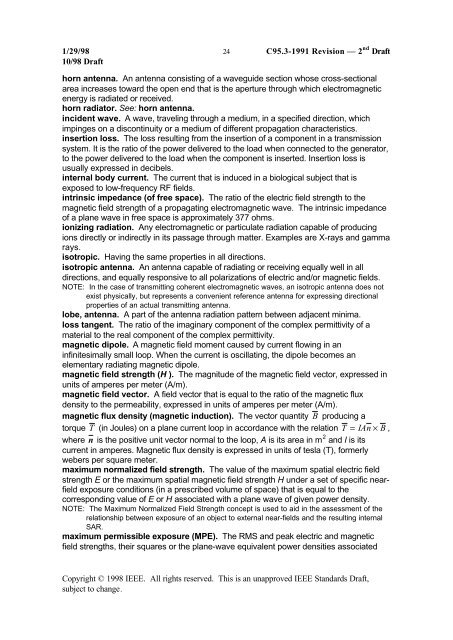DRAFT Recommended Practice for Measurements and ...
DRAFT Recommended Practice for Measurements and ...
DRAFT Recommended Practice for Measurements and ...
Create successful ePaper yourself
Turn your PDF publications into a flip-book with our unique Google optimized e-Paper software.
1/29/98 24 C95.3-1991 Revision — 2 nd Draft<br />
10/98 Draft<br />
horn antenna. An antenna consisting of a waveguide section whose cross-sectional<br />
area increases toward the open end that is the aperture through which electromagnetic<br />
energy is radiated or received.<br />
horn radiator. See: horn antenna.<br />
incident wave. A wave, traveling through a medium, in a specified direction, which<br />
impinges on a discontinuity or a medium of different propagation characteristics.<br />
insertion loss. The loss resulting from the insertion of a component in a transmission<br />
system. It is the ratio of the power delivered to the load when connected to the generator,<br />
to the power delivered to the load when the component is inserted. Insertion loss is<br />
usually expressed in decibels.<br />
internal body current. The current that is induced in a biological subject that is<br />
exposed to low-frequency RF fields.<br />
intrinsic impedance (of free space). The ratio of the electric field strength to the<br />
magnetic field strength of a propagating electromagnetic wave. The intrinsic impedance<br />
of a plane wave in free space is approximately 377 ohms.<br />
ionizing radiation. Any electromagnetic or particulate radiation capable of producing<br />
ions directly or indirectly in its passage through matter. Examples are X-rays <strong>and</strong> gamma<br />
rays.<br />
isotropic. Having the same properties in all directions.<br />
isotropic antenna. An antenna capable of radiating or receiving equally well in all<br />
directions, <strong>and</strong> equally responsive to all polarizations of electric <strong>and</strong>/or magnetic fields.<br />
NOTE: In the case of transmitting coherent electromagnetic waves, an isotropic antenna does not<br />
exist physically, but represents a convenient reference antenna <strong>for</strong> expressing directional<br />
properties of an actual transmitting antenna.<br />
lobe, antenna. A part of the antenna radiation pattern between adjacent minima.<br />
loss tangent. The ratio of the imaginary component of the complex permittivity of a<br />
material to the real component of the complex permittivity.<br />
magnetic dipole. A magnetic field moment caused by current flowing in an<br />
infinitesimally small loop. When the current is oscillating, the dipole becomes an<br />
elementary radiating magnetic dipole.<br />
magnetic field strength (H ). The magnitude of the magnetic field vector, expressed in<br />
units of amperes per meter (A/m).<br />
magnetic field vector. A field vector that is equal to the ratio of the magnetic flux<br />
density to the permeability, expressed in units of amperes per meter (A/m).<br />
magnetic flux density (magnetic induction). The vector quantity B producing a<br />
torque T (in Joules) on a plane current loop in accordance with the relation T = IAn × B ,<br />
where n is the positive unit vector normal to the loop, A is its area in m 2 <strong>and</strong> I is its<br />
current in amperes. Magnetic flux density is expressed in units of tesla (T), <strong>for</strong>merly<br />
webers per square meter.<br />
maximum normalized field strength. The value of the maximum spatial electric field<br />
strength E or the maximum spatial magnetic field strength H under a set of specific nearfield<br />
exposure conditions (in a prescribed volume of space) that is equal to the<br />
corresponding value of E or H associated with a plane wave of given power density.<br />
NOTE: The Maximum Normalized Field Strength concept is used to aid in the assessment of the<br />
relationship between exposure of an object to external near-fields <strong>and</strong> the resulting internal<br />
SAR.<br />
maximum permissible exposure (MPE). The RMS <strong>and</strong> peak electric <strong>and</strong> magnetic<br />
field strengths, their squares or the plane-wave equivalent power densities associated<br />
Copyright © 1998 IEEE. All rights reserved. This is an unapproved IEEE St<strong>and</strong>ards Draft,<br />
subject to change.
















